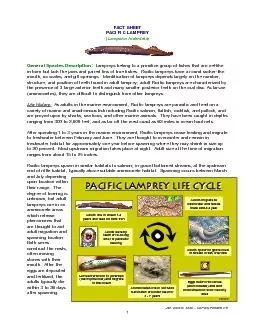PDF-PACIFIC LAMPREY Lampetra tridentata
Author : briana-ranney | Published Date : 2015-08-22
General Species Description Lampreys belong to a primitive group of fishes that are eellike in form but lack the jaws and paired fins of true fishes Pacific lampreys
Presentation Embed Code
Download Presentation
Download Presentation The PPT/PDF document "PACIFIC LAMPREY Lampetra tridentata" is the property of its rightful owner. Permission is granted to download and print the materials on this website for personal, non-commercial use only, and to display it on your personal computer provided you do not modify the materials and that you retain all copyright notices contained in the materials. By downloading content from our website, you accept the terms of this agreement.
PACIFIC LAMPREY Lampetra tridentata: Transcript
General Species Description Lampreys belong to a primitive group of fishes that are eellike in form but lack the jaws and paired fins of true fishes Pacific lampreys have a round suckerlike mout. Rockefeller Jr Memorial PKWY Big Hole NB Cowpens NB Fort Donelson NB Fort Necessity NB Moores Creek NB Petersburg NB Stones River NB Tupelo NB Wilsons Creek NB Kennesaw Mountain NBP Richmond NBP Brices Cross Roads NBS Chickamauga and Chattanooga NMP Health Priorities . in . the USAPIs . Presentation. USAPI NCD Strategic Response Timeline 2010-15. Pacific NCD Roadmap. 20. th. MCES Resolution 20-2. Heads of Health Meeting, Fiji, February 2015. Health Islands Healthy People Review – 2014. and Asian Americans . Are . there differences?. Archana. J. McEligot, PhD. CSU Fullerton. HESC 470. Provide data on AA & NHPI diversity. Distinguish groups geographically and culturally. a. Asian Americans. Inspector P Stokes. New Zealand Police. Pacific Strategic advisor . Tabled Information C. Why have Pacific Wardens. Pacific People population in Wellington -largest outside of Auckland.. Helping their own Communities. Pacific-American Climate Fund. Goal: . Increase adoption of . climate change adaptation measures and . improve resilience in 12 Pacific Island nations. .. Pacific-American Climate Fund. Objectives:. For improved natural resource and water resource management; and. ENSO and the PDO. Michael Alexander. Earth System Research Lab. http://www.cdc.noaa.gov/people/. michael.alexander. /publications/. Data Coverage from Ships of Opportunity. % of months with at least . . A working Paper. …(a new comers PWWA journey). Gender dimension of access to water and sanitation in the Pacific. Development sector rhetoric . Shares some statistics. Realities on the ground. Examines the gender impact of small infrastructure investments . CONSISTENCY, IRRATIONALITY OR THE EMERGENCE OF AUTHENTIC LOCAL COMMON LAW?. Anita Jowitt. University of the South Pacific. ALTA. , . 7-9 July . 2016. Victoria University, Wellington. From ALTA day 1/Law & Culture. End-of-Decade Notes on Education for All Progress: . . Youth and Adult Literacy (Goal 4). Key objectives of EDN Goal 4 on Literacy. Take stock of progress made in literacy in th. e. Asia-Pacific region. Matching Commitments and Resources. Toshi. Yoshihara. U.S. Naval War College. Snapshot of Global Commons. 2007 Maritime Strategy. . “. Credible combat power will be continuously postured in the Western Pacific and the Arabian Gulf/Indian Ocean. WFTO Conference – Rio de Janeiro, Brazil – May 2013. 6 Countries – 23 Members. Canada. USA. New Zealand. Australia. Papua New Guinea. Japan. Australia – 4 members. Fair Trade Assoc. of Australia & New Zealand (FTAANZ). Regional Conference. 1-2 December 2016. Lochie Teague. Service Clinical Director. Starship Children’s Hospital. How do Pacific people with . c. hildhood cancer compare with others in NZ and around the world?. Learning objectives. To view a group of Pacific North Westerners who do not conform to the norms.. To determine whether the PNW breeds serial . To present a research project clearly conveying ideas . Friday . 17 February. Looking down the pipeline. Aid Suppliers Conference: PNG & the Pacific. Oda. to the pacific in 2016-17 is estimated to be $1.1 billion. Aid Suppliers Conference: PNG & the Pacific.
Download Document
Here is the link to download the presentation.
"PACIFIC LAMPREY Lampetra tridentata"The content belongs to its owner. You may download and print it for personal use, without modification, and keep all copyright notices. By downloading, you agree to these terms.
Related Documents














